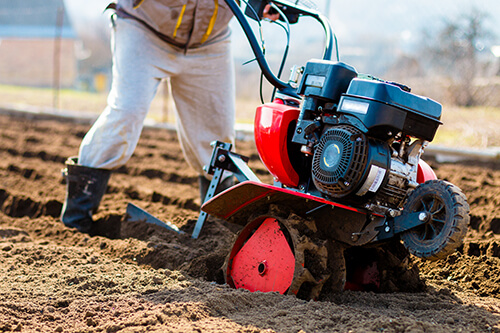Finding the Right Tiller
Mar 16, 2020

Gardening preparation season is in full swing. Whether you’re a seasoned professional or just getting started, finding the right tiller is important. Tillers make your job easier and your soil healthier. Finding the right tiller is all about weighing each option — including wheel size, tine placement, and engine capacity — and finding the right fit for you.
Wheel size
Tillers can weigh up to 130 pounds, so good wheels are an essential. Make sure the wheels are large enough to get your tiller from the shed to the garden without wearing you out.
Front-tine tillers
Front-tine tillers are lightweight but handy. Because the tines rotate forward, they actually help propel the machine along. These tillers are great for big areas that are already cut and need maintenance or to get in between rows to freshen the soil and clean out weeds. Front-tine tillers are not as easy to handle on fresh ground.
Rear-tine tillers
The tines on a rear-tine tiller can rotate in three different ways: forward-rotating, which helps to push forward and blend soil; counter-rotating, which helps it dig deeper; and dual-rotating, which allows the switching between the modes. Although these tillers can be used for weeding and blending, the large engine is best suited for breaking up new ground, especially in sandy or loamy soil. They are user-friendly and easy to maneuver.
Engine capacity
Front-tine tillers will have the engine capacity of 165 and 205cc, enough to break up unloosened, softer soils. Rear-tine tiller engines are bigger and are strong enough to break up that hard ground and make loose, soft soil ready for spring seeds.
Once you’ve considered these options, visit your local Co-op. We can help you find the perfect tiller of any size, brand, or type that will match the needs of you and your garden.
Wheel size
Tillers can weigh up to 130 pounds, so good wheels are an essential. Make sure the wheels are large enough to get your tiller from the shed to the garden without wearing you out.
Front-tine tillers
Front-tine tillers are lightweight but handy. Because the tines rotate forward, they actually help propel the machine along. These tillers are great for big areas that are already cut and need maintenance or to get in between rows to freshen the soil and clean out weeds. Front-tine tillers are not as easy to handle on fresh ground.
Rear-tine tillers
The tines on a rear-tine tiller can rotate in three different ways: forward-rotating, which helps to push forward and blend soil; counter-rotating, which helps it dig deeper; and dual-rotating, which allows the switching between the modes. Although these tillers can be used for weeding and blending, the large engine is best suited for breaking up new ground, especially in sandy or loamy soil. They are user-friendly and easy to maneuver.
Engine capacity
Front-tine tillers will have the engine capacity of 165 and 205cc, enough to break up unloosened, softer soils. Rear-tine tiller engines are bigger and are strong enough to break up that hard ground and make loose, soft soil ready for spring seeds.
Once you’ve considered these options, visit your local Co-op. We can help you find the perfect tiller of any size, brand, or type that will match the needs of you and your garden.